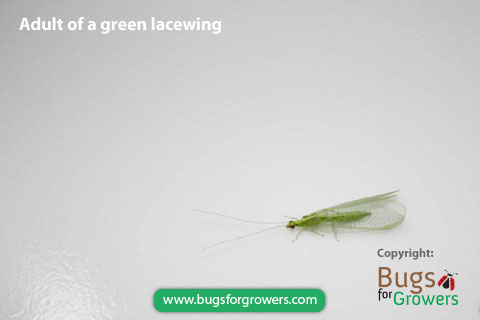Green lacewings, Chrysoperla rufilabris are predators of soft-bodied insect pests
Click YouTube video below to learn about predatory green lacewings and how they control aphids and other insect pests.
Green lacewings, Chrysoperla rufilabris are currently used as the most aggressive insect predators for controlling many greenhouse insect pests including aphids (green apple aphid, Aphis pomi and brown citrus aphid, Toxoptera citricida), whiteflies, mealybugs, pest mites, scale insects and thrips. The larvae of green lacewing are also predators of larvae of many Lepidopterous insects. Green lacewing adults are about 0.5 inch long green colored insects with big eyes, very long antennae and two pairs of transparent wings (Fig. 1). Green lacewing larvae kill and feed on different stages of insect hosts whereas their adults feed on nectar, pollen and honeydews. Mature larvae of green lacewing look like small alligators, which are also called as “aphid lions”. These aphid lions are about 0.5 inch long, brown in color with yellow markings on their body and they have curved jaws called mandibles that are used for catching and puncturing of their prey and then sucking body content of the punctured prey.

Green lacewings are commercially available. Predatory green lacewings are sold in three different developmental stages including eggs, larvae and adults. Of these three stages, only larval stages are predatory in nature and known to feed on their host insects. Eggs of green lacewings can be placed directly in garden. This direct application of eggs can be very effective if their hatching can coincides with the outbreak of target pests such as aphids, thrips and whiteflies. Direct application of larvae in the greenhouse generally helps to quick control of heavy infestations of aphids and other soft bodied insects. When adults of green lacewing are released, their females generally lay eggs on the plants that are heavily infested with host insects. These eggs then hatch into larvae that feeds voraciously on different stages of aphids and other host insects. These predatory larvae are known to destroy and eat over 200 aphids within a week. The larval stage of green lacewing can last for 2-3 weeks in the greenhouse at optimum temperature. These green lacewings are very effective as biological control agents in the greenhouse when released at temperatures between 67 to 89°F (19-31.6°C) and above 30% relative humidity.
What are the advantages of releasing predatory green lacewings in the greenhouse settings?
Predatory green lacewings Chrysoperla rufilabris help to reduce the crop damage by feeding on the soft bodied insect pests that are responsible for causing a serious damage to many crops and ornamental plants grown in the greenhouses. These predatory insects are very active and therefore, they are able to actively search, kill and eat their hosts including aphids, mealybugs, mites, immature stages of whiteflies and caterpillars/larvae of different insect pests. If host insects are available they can recycle themselves after first application in the greenhouses or gardens. Green lacewings, Chrysoperla rufilabris are commercially available and they are easy to apply in the greenhouses or gardens. Predatory green lacewings Chrysoperla rufilabris do not cause any damage to plants. Also, predatory green lacewings Chrysoperla rufilabris are not harmful to human, pets and the environment.
Research papers
- Chen, T. –Y. and Liu, T.-X. 2001. Relative consumption of three aphid species by the lacewing, Chrysoperla rufilabris, and effects on its development and survival. BioControl 46: 481-491.
- Grasswitz, T.R. and Burts, E.C. 1995. Effect of native natural enemies and augmentative releases of Chrysoperla rufilabris Burmeister and Aphidoletes aphidimyza (Rondani) on the population dynamics of the green apple aphid, Aphis poMi De Geer. International Journal of Pest Management 41: 176-183.
- Michaud, J. P. 2001. Evaluation of green lacewings, Chrysoperla plorabunda (Fitch) (Neurop., Chrysopidae), for augmentative release against Toxoptera citricida (Hom., Aphididae) in citrus. Journal of Applied Entomology 125: 383–388.
- Stewart, C. D., Braman, S.K. and Pendley, A.F. 2002. Functional Response of the azalea plant bug (Heteroptera: Miridae) and a green lacewing Chrysoperla rufilabris (Neuroptera: Chrysopidae), two predators of the azalea lace bug (Heteroptera: Tingidae). Environmental Entomology 31:1184-1190.
